In our hectic, constantly-connected world, finding ways to relax and de-stress is more important than ever. For some people, finding that peace and calm can be as simple as retreating to their own personal calming space.
A calming space can be any quiet corner of your home where you can go to escape the noise and stress of everyday life. Creating this space is not difficult, but it does require some thought and planning.
In this article, we’ll discuss how to create a calming space, what to include in it, and how to use it for relaxation and stress relief.
What Is A Calming Space?
A calming space is a place where you can go to relax and de-stress. It can be anywhere that makes you feel comfortable and safe, such as your bedroom, a park, or even a quiet corner of the library. The important thing is that it is a place where you can clear your mind and focus on calming your body and emotions.
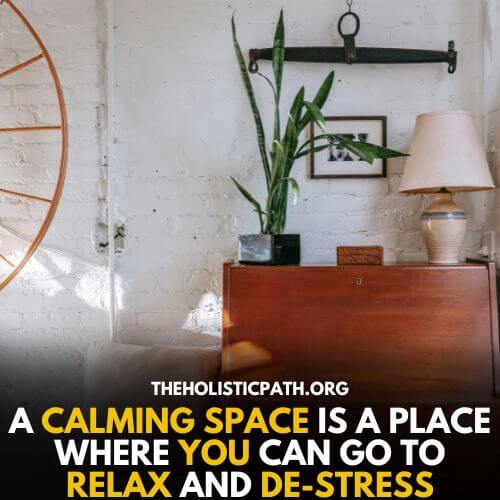
Some people like to include calming activities in their calming space, such as reading, yoga, or meditation. Others simply find that being in a calming environment is enough to help them feel more relaxed.
Whatever works for you, the important thing is to have a space where you can take a break from the hustle and bustle of everyday life and just breathe.
Why We Need A Calming Space
We all know how important it is to have a calming space in our lives. Whether it’s a corner of our bedroom or a specific spot in our living room, having a place where we can go to relax and regroup can make a world of difference. Here are just a few of the reasons why we need a calming space:
- To escape the hustle and bustle of everyday life. We all lead busy lives and sometimes it can be overwhelming. Having a calming space gives us somewhere to go to take a break from it all.
- To clear our minds. A calming space provides us with a chance to clear our heads and re-centre ourselves. It’s a chance to step away from whatever is stressing us out and take some time to breathe.
- To relax our bodies. When we’re feeling tense or anxious, our bodies tend to reflect that. Taking some time to relax in a calming space can help to physically unwind and ease muscle tension.
So, there you have it! A few of the many reasons why calming spaces are so important. If you don’t have one already, maybe now is the time to create one!
Benefits Of Having A Calming Space In Your Home
A calming space is a place where you can go to relax and feel at peace. It can be anywhere in your home, from a cozy nook to a secluded corner. Creating a calming space is a great way to reduce stress, boost your mood, and promote relaxation.
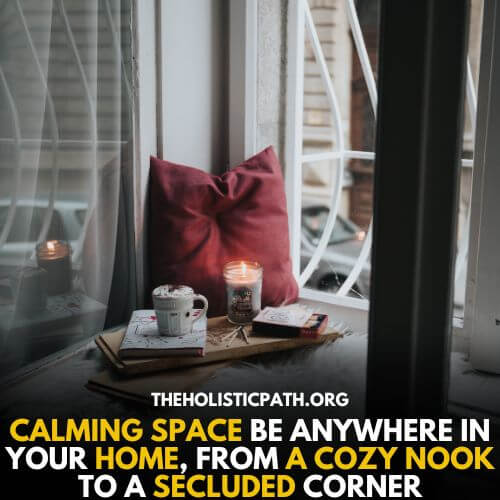
Here are some benefits of having a calming space in your home:
- A calming space can help you to relax and de-stress. If you have a busy lifestyle, it can be difficult to find time to relax. Having a dedicated space in your home where you can go to unwind can make a big difference. Simply being in a calming environment can help to lower your heart rate and relieve muscle tension.
- A calming space can boost your mood and promote positive feelings. When you take time out to relax in your calming space, it can help to improve your outlook on life. You may find that you feel happier and more optimistic after spending some time in your calming space.
- A calming space can promote better sleep. If you have trouble sleeping, spending some time in your calming space before bed may help. The relaxing environment can help to prepare your mind and body for sleep, making it easier to fall asleep and stay asleep through the night.
When To Use A Calming Space
When someone is feeling overwhelmed, anxious, or stressed, it can be helpful to take a break in a calming space. Calming spaces are designed to help reduce stress and promote relaxation. They can be found in many different settings, including schools, workplaces, hospitals, and airports.
Scientific evidence suggests that calming spaces can help to lower heart rate and blood pressure, reduce levels of the stress hormone cortisol, and improve mood and well-being.
How To Use Your Calming Space For Relaxation And Meditation
Everyone has their own way of calming down and de-stressing. Maybe you like to take a hot bath, read a book, or go for a walk in nature. No matter what calming activity you choose, it’s important to have a designated space in your home where you can go to relax and rejuvenate.
This calming space should be free from distractions like electronics, work materials, or anything else that might cause stress. Once you have created your calming space, there are a few different ways you can use it to relax and meditate.
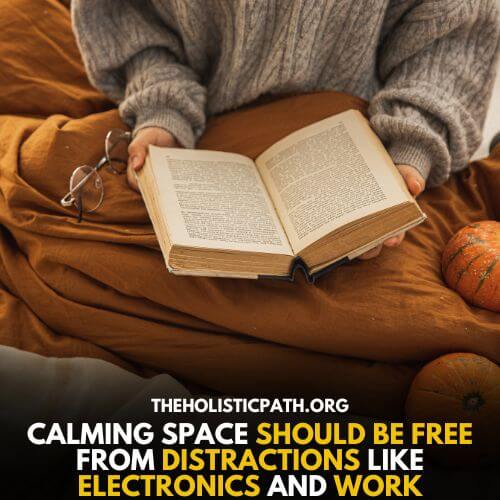
You might want to start by simply sitting in silence and enjoying the peace and quiet. If you find it difficult to sit still, you can try using guided meditation apps or podcasts. There are also many relaxation techniques that can be done sitting or lying down, such as deep breathing exercises or progressive muscle relaxation.
If you prefer to move around while you calm down, some calming activities that can be done in your space include yoga, Tai Chi, or gentle stretching. Choose whatever calming method works best for you and make time each day to unwind in your personal oasis.
20 Ways To Create A Calming Space
Creating a calming space can be important for both your physical and mental health. There are many simple things you can do to create a calming environment. Here are just a few ideas:
1. Use Calming Colors:
When it comes to decorating a calming space, color is key. Different colors can have different effects on our moods and emotions, so it’s important to choose wisely. Calming colors tend to be soft, gentle, and calming.
Some calming blue, green, pale pink and lilac are all great choices.
Using these colors in your decor can help to create a serene and calming atmosphere. Of course, you don’t have to use only calming colors – a mix of calming and vibrant colors can also be effective. Just be mindful of the overall tone you’re trying to create in the space.
Too many bright colors can be overwhelming, so it’s important to strike the right balance. With a little bit of thought and planning, you can easily create a calming space that is both beautiful and calming.
Here are a few examples of colors that are known to promote relaxation:
- Blue: Blue has long been associated with tranquility and peace. Its calming properties make it a great choice for bedrooms and bathrooms.
- Lavender: Lavender is another calming color that can help to promote relaxation. It’s often used in spas and meditation rooms for its ability to help people unwind.
- Green: Green is the color of nature, and it’s no surprise that it can have a calming effect on the mind and body. If you’re looking for a calming color for your walls, consider a light green or mint shade.
2. Bring Nature Inside:
Have you ever noticed how being in nature can make you feel calmer and more relaxed? There’s a reason for that – studies have shown that spending time in nature can lower stress levels, improve mood, and boost overall mental health. And if you can’t get outside as much as you’d like, there are ways to bring nature inside your home.
One way to do this is by incorporating plants into your décor. Plants not only add a splash of color and life to a room, but they also help to purify the air and boost mental well-being. You can also try adding natural elements like wood or stone into your home.
The calming texture and visuals of these materials can help create a more soothing environment. Just be sure not to go overboard – too many knick-knacks can actually have the opposite effect and make a space feel cluttered and chaotic.
3. Incorporate Soft Textures:
Textures can also play a role in creating a calm environment. Soft, plush fabrics tend to be more inviting and calming than harsh, scratchy materials. Or choose furniture with softer upholstery. The idea is that these softer textures help to reduce noise and create a more calming atmosphere.
Another way to incorporate soft textures is through the use of fabric curtains or blinds. These can help to muffle sound and provide an additional layer of insulation, making a space feel more serene.
4. Add Some Soothing Scents:
When you walk into a room, the first thing you notice is the smell. Whether it’s a pleasant scent or an unpleasant one, it can have a big impact on how you feel. If you’re looking to create a calming space, adding some soothing scents can be a great way to do it.
Aromatherapy is a great way to promote relaxation. Lavender is known for its calming properties, so adding a lavender-scented candle or diffuser can help to create a calming atmosphere. You could also try adding some essential oils to a diffuser.
Some other calming scents include chamomile and ylang-ylang. If you want to create a truly relaxing space, experiment with different scents until you find the perfect combination for you.
5. Add Some Softness:
When you’re trying to create a calming space, it’s important to consider all of your senses. What you see, hear, and smell can all have an effect on your level of stress. But don’t forget about touch! Adding some softness to your space can help to create a feeling of calm.
A fluffy rug or a comfy couch can make a big difference. And if you really want to go all out, you can even invest in a massage chair! Just being able to sink into something soft and comfortable can help to reduce your stress levels.
So if you’re looking for ways to create a more calming environment, don’t forget about the power of touch.
6. Control The Lighting:
One of the most important (and often overlooked) aspects of creating a calming space is controlling the lighting. Too much light can be harsh and glaring, while too little light can make a space feel cramped and ominous.
Instead, aim for a middle ground where the lighting is soft and inviting. If you need to use artificial light, make sure to use diffusers or frosted bulbs to soften the harshness of the light. By taking control of the lighting in your space, you can create an environment that is calming and inviting.
7. Eliminate Clutter:
We all know the feeling of coming home to a cluttered, messy house. It can be overwhelming and stressful, making it difficult to relax and unwind. On the other hand, walking into a calm, orderly space can immediately help to lower your stress levels.
When you eliminate clutter from your home, you create a calming environment that is more conducive to relaxation and peace of mind.
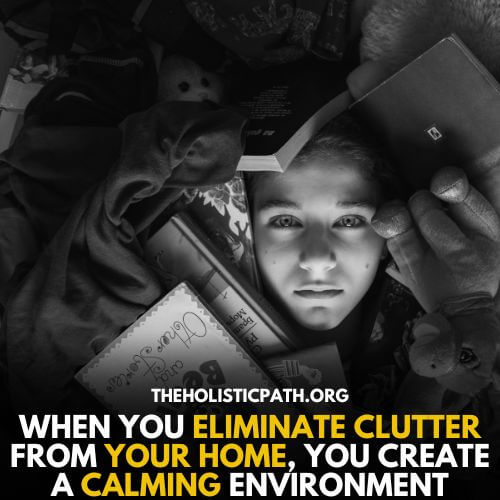
Furthermore, decluttering can also help you to feel more organized and in control. When your space is chaos, it can feel like your life is out of control. But by decluttering, you take back control of your environment and give yourself a sense of calm and order.
So if you’re looking to create a more calming space, start by decluttering and getting get rid of anything that doesn’t serve a purpose or that you don’t truly love. You may be surprised at how much of a difference it makes.
8. Add A Personal Touch:
When it comes to creating a calming space, there’s nothing quite like adding a personal touch. Whether it’s a simple vase of flowers or a collection of family photos, incorporating items that have special meaning can help to chase away the stresses of everyday life.
In our hectic world, it’s more important than ever to take a few moments for self-care. By taking the time to create a calming space in our homes, we can give ourselves the opportunity to relax and recharge. So go ahead and add that personal touch – your mind (and body) will thank you for it.
9. Create A Comfortable Seating Area:
One of the most important aspects of creating a calming space is making sure you have a comfortable place to sit. Whether it’s a cozy armchair, a pile of pillows, or simply a well-designed floor cushion, taking the time to find the perfect spot to relax will make all the difference.
You might also want to consider investing in a recliner or bean bag chair.
Once you’ve found your seat, it’s also important to pay attention to your posture. Make sure you’re sitting up straight with your back supported and your feet planted firmly on the ground. This will help you to avoid tension headaches and fatigue.
Finally, take a few deep breaths and allow yourself to drift off into a calming state. With a little effort, you can transform any space into a calming oasis.
10. Add Calming Background Noise:
One way to create a calming space is by adding calming background noise. This can help to mask disruptive sounds and promote a feeling of relaxation. There are many different types of calming background noise, from the sound of rain falling to the gentle murmur of a stream.
Some people find that white noise helps them to focus, while others prefer more natural sounds. Whichever type of noise you choose, make sure that it is not too loud or overwhelming. calming background noise should be soothing and unobtrusive, helping you to relax and unwind.
11. Use The Stones:
There’s something about stones that just feels calming. Maybe it’s their solidity or the way they’re natural and grounding. Whatever the reason, using stones to create a calming space is a great way to find a little peace in your day-to-day life.
One of the easiest ways to do this is with a stone meditation garden. Find a spot in your yard or on your patio where you can arrange a few stones in a pretty pattern. Then, when you need a break from life’s chaos, take a seat and focus on your breathing. Let the stones surround you with calm as you clear your mind and relax.
You can also use stones to create a calming atmosphere indoors. Place a few large river rocks in an empty fireplace, or fill a glass bowl with colorful beach pebbles. Or, if you really want to get creative, try making your own Zen sand garden. Just grab a box or tray, fill it with sand, and add some stones for decoration.
Then, whenever you need a quick calming activity, sit down and rake the sand into calming patterns. It’s super satisfying and incredibly relaxing!
12. Incorporate Sand:
It’s no secret that our environment can have a big impact on our mood. If we’re constantly surrounded by chaos and clutter, it can be hard to feel calm and centered. That’s why many people choose to incorporate elements of nature into their décor, in order to create a calming space.
One of the most popular nature-inspired materials is sand. Whether it’s used in a vase as part of a Zen garden, or simply scattered on a windowsill, the soft, granular texture of sand can help to soothe and relax us. In addition, the calming hue of most sands can help to create a sense of tranquility.
By incorporating even a small amount of sand into our décor, we can help to transform our space into a calming oasis.
13. Wall Art:
Wall art can be a great way to create a calming space. This is because it can help to focus the eye and add a feeling of tranquility to a room. Elements that can be used in calming wall art include soft colors, nature scenes, and geometric patterns.
Look for pieces that make you feel relaxed and comfortable, and consider hanging them in a place where you will see them often.
14. Get Rid Of Electronics:
If you’re looking to create a calming space, getting rid of electronics can be a great first step. Our phones, laptops, and TVs are constant sources of stimulation, and they can be really tough to tune out. So by decluttering your space of screens, you can help yourself to relax and feel more at ease.
Instead of using electronics as a source of entertainment, try picking up a book, playing an instrument, or spending time with a loved one. These activities can help to ground you and remind you of what’s truly important in life.
So if you’re looking to create a calming oasis, getting rid of electronics is a great place to start.
15. Candles:
Many people find candles to be helpful in creating a calming space. The gentle flickering can help to relax the mind and body, promoting a sense of peace and well-being. The soft light and calming scent can help to relax the mind and body, making it easier to fall asleep or just unwind after a long day.
There are many different candles and scents to choose from, so you can find one that suits your needs. Some popular calming scents include lavender, chamomile, and vanilla. You can also find candles with other soothing elements like calming colors or calming imagery.
16. Make Sure There’s Plenty Of Natural Light:
Natural light has a calming effect on the mind and body, making it an important element in creating a calming space. Exposure to sunlight helps to regulate the body’s production of melatonin, a hormone that helps to promote sleep.

In addition, natural light can help to increase levels of serotonin, a neurotransmitter that is known to improve mood and alleviate stress. If you are looking to create a calming space in your home, there are a few easy ways to incorporate more natural light.
Opening blinds and curtains during the day will allow sunlight to enter the room, and adding mirrors to walls can help to reflect light and brighten up the space. Finally, painting walls in light colors will also help to make a room feel more open and airy.
By incorporating some or all of these elements, you can create a calming space that promotes relaxation and well-being.
17. Temperature Matters:
There are a few different things you can do to create a calming space, but one of the most important is to control the temperature. A warm room can make you feel drowsy and sluggish, while a cool room can help to wake you up and energize you.
The best temperature for a calming space is usually somewhere in the middle, around 68 degrees Fahrenheit. This temperature is comfortable without being too hot or too cold, and it won’t make you feel sleepy or jittery.
Be sure to pay attention to the temperature!
18. Let Go Of Perfectionism:
Trying to achieve perfection is often unrealistic and ultimately unattainable – not to mention stressful! Instead of striving for perfectionism, focus on creating a space that makes YOU happy. Everyone’s definition of “calm” is different, so trust your instincts when creating your own calming space.
19. Add Some Cozy Blankets And Pillows:
Adding some cozy blankets and pillows can definitely help in creating a calming space. Not only do they add some visual interest and texture, but they also invite people to relax and get comfortable. The right blanket or pillow can make all the difference in how calming a space feels.
If you’re going for a more serene atmosphere, choose calming colors and materials like cotton or linen. And if you want something a little more fun or festive, go for brighter colors and patterns. Either way, adding some cozy blankets and pillows is a great way to create a calming space.
20. Create An Oasis Of Peace:
Ultimately, the goal is to create a space that feels like an oasis – a haven from the hustle and bustle of everyday life. By incorporating some or all of these calming elements, you can create a tranquil retreat that will help you relax and recharge.
Places Where We Can Have Calming Space
We all need a calming space in our lives – a place where we can go to unwind, relax, and recharge. For some people, this calming space is their home; for others, it’s their office or another place entirely. Regardless of where it is, having a calming space is essential for maintaining our mental health and well-being.
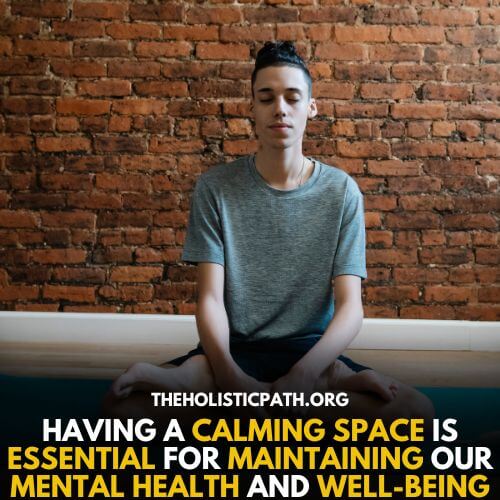
Here are some of the most common places people find calming spaces:
- Homes: For many people, their homes are the most calming and safe place they can be. There’s something about being in your own space that just feels comforting and reassuring. If you don’t have a lot of peace and quiet at home, consider carving out a corner or room that you can make into your own personal oasis.
- Offices: For people who work in busy or stressful environments, their offices can be a much-needed calming space. If you have your own office, take advantage of it and make it as calming and soothing as possible. If you don’t have your own office, try to find a quiet spot where you can go to take a break from the hustle and bustle.
- Nature: There’s something about being in nature that can instantly help to calm and relax us. If you’re feeling stressed, try taking a walk in the park, going for a hike, or simply spending time outdoors in your backyard or garden. The fresh air and calming scenery will do wonders for your state of mind.
There are a few key factors that make up a calming space. First, it should be free from clutter and distractions. This means no piles of laundry or stacks of paperwork. Second, it should have calming colors and lighting. Take some time to find a calming space that works for you.
It’ll make all the difference in your overall mental health and well-being.
Items To Have In A Calming Space
If you are clueless as to what items you should have in your calm space, then following this list of 31 items that you can have in your calm space:
- A comfortable chair or sofa
- A soft blanket or throw
- Pillows
- calming colors such as blue, green, or lavender
- A diffuser with calming essential oils such as lavender or chamomile
- A plant or fresh flowers
- A table lamp with a soft light bulb
- A basket for storing blankets and pillows
- Books, magazines, or journals
- A relaxing scented candle
- Coloring books and crayons
- Stress balls or squishy
- Noise-canceling headphones
- earplugs
- A neck pillow or eye mask for if you want to nap
- herbal tea bags
- a mug and kettle for making tea
- A notebook and pen for journaling
- A laptop or tablet for watching calming videos or listening to calming music
- A small stack of coasters
- Fuzzy socks
- A cozy robe
- Slippers
- Lotion
- Chapstick
- A water bottle
- Snacks such as nuts, fruit, or trail mix
- A list of things that make you happy
- Pictures or posters of things that make you happy
- Quotes that make you happy
- A calendar so you can see upcoming events that make you happy
12 Activities For Calm Space
Here are 12 interesting activities that you can do in your calm space and relax:
- Drink herbal tea
- Do some light stretching or yoga
- Write in a journal
- Draw or paint
- Make a collage
- Listen to calming music or audio recordings
- Engage in calming activities like yoga or meditation
- Practice deep breathing exercises
- Practice self-care and eat healthy foods
- Play with clay or another tactile activity
- Reread a favorite book from childhood
- Make a list of things you’re grateful for
How To Create A Calming Space In A Small Place
It can be difficult to create a calming space in a small home or apartment, but it is possible with a little bit of creativity. Here are some tips for creating a calming space in a small place:
- Use light colors on the walls and floor. Light colors tend to be calming and can make a space feel larger.
- Bring in some plants. Plants can help to purify the air and add a calming touch to a space.
- Choose simple, clean furniture. Avoid overly cluttered or busy patterns.
- Add some soft lighting. Lighting can have a big impact on the atmosphere of a space. Soft, calming lighting can help to create a feeling of peace.
- Make sure the space is well-organized. A tidy space will help you feel calm and relaxed.
- Add some personal touches. Include items that make you happy and remind you of good memories.
Final Thought
In conclusion, having a calming space in your home can be extremely beneficial. A calming space can be a valuable asset for anyone who struggles with anxiety or stress. It can help you to relax and de-stress and can provide a much-needed respite from the hustle and bustle of daily life.
If you don’t have a dedicated calming space, it’s well worth taking the time to create one. Just a few simple changes can make a big difference, and you’ll be glad you did.
